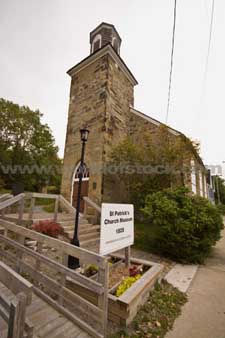St. Patrick's
Museum 1828
St. Patrick's Church is one and a half stories
high, a gothic revival style stone structure that is located in
Sydney, Nova Scotia, constructed between 1828 and 1830, and is
the oldest standing Roman Catholic church in eastern Nova
Scotia, with a small graveyard located next to it that began in
1798. The church is significant for its age and role in the
history of the Roman Catholic church on Cape Breton Island,
constructed because of the efforts of the area's first Roman
Catholic parish priest, Henry MacKeagney. In 1828, the small
congregation had raised enough funds to replace the original
wooden church with the current stone one, but would continue to
grow and grow until the congregation became too large for the
small church to accommodate, so in 1855, renovations would start
that added balconies on three sides and a raised sanctuary
constructed on the south end. Then, again, in 1872, the
congregation had outgrown this church as well, so they decided
to build a larger church. Sacred Heart would be constructed and
the congregation left St. Patrick's, but would come back in 1876
after a fire would destroy the new church. The congregation
would continue going to St. Patrick's while another church was
built, and afterwards would be used as the church hall. The
church would eventually become more useful as the city grew and
welcomed the Maronite community. These were Lebanese and Syrian
families that had immigrated to Sydney in the early years of the
20th century. The vast majority of these folks were Maronites;
members of one of the Eastern rites of the Catholic church, so,
in 1912, the Lebanese Maronite community would start coming to
this church led by Father Saoib. It is now thought that this was
the first permanent place of worship for these people in the new
world, but would eventually abandon the church after Saoib
retired in 1950. The Old Sydney Society would start a museum in
the old church to preserve it and the many relics kept there.
|

